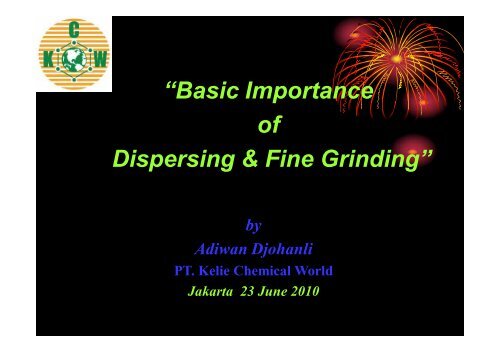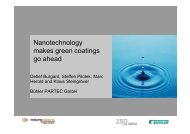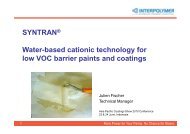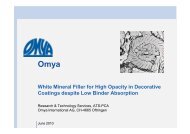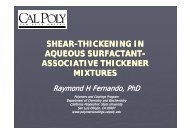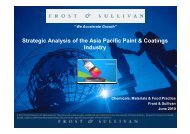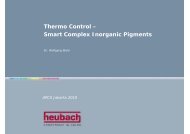Dispersion - Quartz Presentations Online
Dispersion - Quartz Presentations Online
Dispersion - Quartz Presentations Online
Create successful ePaper yourself
Turn your PDF publications into a flip-book with our unique Google optimized e-Paper software.
“Basic Importance<br />
of<br />
Dispersing & Fine Grinding”<br />
by<br />
Adiwan Djohanli<br />
PT. Kelie Chemical World<br />
Jakarta 23 June 2010
Short biography<br />
• A graduate in Chemistry (B.Sc.) and M.B.A. in Marketing<br />
• Working mostly in Paints / Coatings for more than 30 years in<br />
various positions<br />
• Being: Operator, Supervisor, Chemist, Technical Manager,<br />
General Manager, President Director, Consultant.<br />
• Company: Dulux (ICI) NZ; Raffles Paint, WA Paint& Varnish;<br />
Surface Coatings Australia, Perth, W.A.; PT. Wattyl Dimet<br />
Indonesia; Dimet Malaysia; PT. Akzo Nobel Car Refinishes<br />
Indonesia<br />
• 2005-2007 – Chairman, Indonesian Paint Manufacturers’<br />
Association<br />
• 2006-sekarang – Director / General Manager for PT. Kelie<br />
Chemical World<br />
• Associate Senior Consultant for a Multi national Consulting<br />
Company<br />
• Contributor, writing articles for Asia Pacific Coatings Journal<br />
• Being local agent / representative for ACPS 2010
<strong>Dispersion</strong><br />
• Disperser Blade = 1/3 - 1/2<br />
tank diameter<br />
• Batch level = 3 to 5 Blade<br />
Diameters or 1 to 2 tank<br />
diameter<br />
• Tank size = 30 % > batch<br />
volume<br />
• Immersion depth = 1/2 to 2<br />
Blade Diameters from tank<br />
bottom<br />
• Peripheral Speed 22-28<br />
m/s
Type of Blades
Term Definition<br />
• Agglomerates<br />
– Cluster of aggregates<br />
and/or primary particles in<br />
a relatively open selective<br />
compound<br />
Dry pigment agglomerate<br />
• Aggregates<br />
– Firmly attached compound<br />
of primary particles,<br />
– crystals have contact at big<br />
areas<br />
• Primary particles<br />
– Crystalline or amorphous<br />
particles which are<br />
separate from each other<br />
Primary particle<br />
Aggregate
Conventional <strong>Dispersion</strong><br />
• Product quality highly<br />
dependent on operator skill<br />
and experience<br />
• Powder feed rate need to be<br />
controlled<br />
• <strong>Dispersion</strong> blade height<br />
need to be at correct<br />
position<br />
• <strong>Dispersion</strong> blade speed has<br />
to be adjusted to maintain<br />
VORTEX for optimum<br />
powder wetting<br />
Vortex
High volume dispersion<br />
•Economy of Scale Through Bulk Production<br />
•Reduction of overall production cost through<br />
•Automation:<br />
•Improved Production Capacity<br />
•Reduction of manpower<br />
•Reduction of energy cost<br />
•Consistent & Repeatable Quality <strong>Dispersion</strong><br />
•Higher pigmentations - higher yield
Close dispersion system<br />
• Easy cleaning<br />
• No emission, particularly<br />
vacuum feeding<br />
• Specific design:<br />
– minimum batch 25 %<br />
– more intensive mixing<br />
movement in the bottom<br />
zone<br />
• Automatic control - for quick,<br />
efficient solid feeding<br />
• Load cell brackets, batch<br />
control
Automatic Dispersing System<br />
(ADS)
Another dispersion system<br />
• Specific design:<br />
– Agglomerates break up<br />
due to internal air<br />
expansion<br />
• Dosing and disintegration<br />
of solid<br />
• Very fast dispersion<br />
• Easy cleaning<br />
• No emission, particularly<br />
vacuum feeding<br />
• Automatic control - for<br />
quick, efficient solid feeding<br />
• Flexible batch size<br />
• Can handle wide viscosity<br />
range
Kinds of dispersion<br />
Ideal dispersion<br />
Optimised dispersion<br />
agglomerate<br />
5 µ<br />
5 µ<br />
primary<br />
particle<br />
air<br />
agglomerate<br />
liquid<br />
primary<br />
particle<br />
air<br />
solid agglomerate<br />
liquid
Agitator bead mills<br />
12<br />
‣ Horizontal or vertical<br />
construction<br />
‣ The activation of the<br />
grinding beads by an<br />
agitator shaft with pegs,<br />
disks or smooth-shaped<br />
agitating elements<br />
‣ Grinding chamber is filled<br />
with grinding beads<br />
∅ 0,3 – 4 mm to 70 – 90 %<br />
‣ Continuous product flow<br />
through the grinding<br />
chamber<br />
‣ Separation of the<br />
grinding media from the<br />
product at the outlet with<br />
a separation system<br />
Belt drive<br />
Product outlet Grinding chamber<br />
Separation system Product inlet<br />
Grinding disk<br />
Agitator shaft<br />
Motor
Grinding Media<br />
• Size<br />
• 0.1 mm (100 Microns) to 10<br />
mm<br />
• Typical size ranges used are<br />
• 0.6-0.80.8 mm - High quality<br />
liquid inks, Pigment grinding<br />
or Paper coatings, high-tech<br />
ceramics<br />
• 0.8-1.2 mm - Automotive<br />
coatings<br />
• 1.2 - 1.6 -<br />
Industrial/Architectural<br />
coatings, ceramic<br />
slurries/Slips<br />
• Type<br />
• Plastic - SG ~ 1<br />
• Fill<br />
• Glass - SG ~ 2.5<br />
• Ceramics - SG ~ 4 – 6<br />
• Steel - SG ~ 7<br />
• Percent of mill volume filled by<br />
grinding media<br />
• loaded by Volume or weight<br />
• ~ 40 of media volume is free<br />
space
Media Type: Ceramic<br />
• Zirconia-Silica (SAZ)<br />
• True density =<br />
3.85<br />
• Bulk density = 2.3<br />
• Medium<br />
contamination rate<br />
• Low machine wear<br />
• Price: low cost<br />
• Cerium stabilized<br />
zirconium oxide - Zirconox<br />
True density = 6.0<br />
Bulk density = 3.65<br />
Price: medium cost<br />
• Lower cost than<br />
TZP<br />
• Same density<br />
• Higher wear rate<br />
than TZP<br />
• Yttrium Zirconium Oxide<br />
(YTZP) Torayceram<br />
• True density = 6.0<br />
• Bulk density = 3.65<br />
• Medium contamination<br />
rate<br />
• Price: Highest cost<br />
14
Agitator bead mills<br />
Main parts:<br />
- Drive motor<br />
- Shaft speed<br />
- Agitating disc<br />
- Mechanical seal<br />
- Separation system<br />
- Chamber size and material<br />
PERFORMANCE OF MILL
EFFECT OF REDUCTION IN<br />
PARTICLE SIZE<br />
Pigment is a substance, made of particles, almost<br />
insoluble in the application medium, use as<br />
colouring agent or because of it inhibiting corrosion<br />
or magnetic features<br />
The smaller the particles the better is<br />
the colour density of the pigment.<br />
The colour density is the<br />
measurement of the capability of a<br />
pigment to change the colour of<br />
another material<br />
16
Mixing, Pre-Dispersing<br />
Mixing, Predispersing<br />
• Target:<br />
- Production of a homogeneous<br />
suspension<br />
- Disintegration of aggregates /<br />
agglomerates in the shearing area and<br />
uniform distribution in the liquid<br />
- Wetting of the liquids<br />
- De-aeration<br />
A good pre-mixing process<br />
Note<br />
- Facilitates the grinding process<br />
(increase of grinding capacity)<br />
- Reduces the risk of breakdowns<br />
and poor qualities (sedimentation<br />
in the tank and pipeline, blocking<br />
of the separation unit)
Thank you<br />
for<br />
your kind attention<br />
from:<br />
Adiwan Djohanli<br />
PT. Kelie Chemical World<br />
Rukan Gading Bukit Indah F/12, Jl. Bukit Gading Raya,<br />
Jakarta 14240, INDONESIA. Phone / Fax: +62 21 452 2959.<br />
Mobile: +62 811 99 1595. Email: adiwan.djohanli@gmail.com<br />
http://www.linkedin.com/in/adiwandjohanli14250


